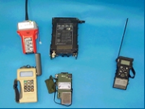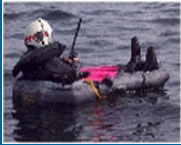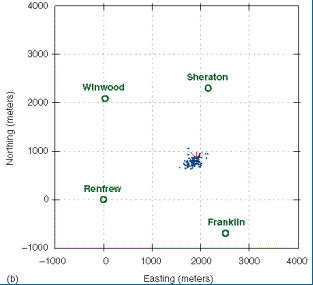GPS/ Location Devices
In order to send a signal from our protective gear
to an authority, we can apply existing technology, and one approach is to
use GPS. One of the providers of GPS service if the US government, it offers
the "Standard Positioning Service" to the users worldwide. The 95-percentile
accuracy of this system is 100m, which means the actual position of the signal
origin is no farther than 100m of the calculated position 95% of the time.
An advantage of the GPS system is that its ground station can be a mobile
unit like an ambulance so the rescuers can locate the wounded directly without
contacting other authorities. And because satellites are orbiting around the
earth, this system has no limited range. However, in order to apply this technology,
it is necessary to implement a GPS device (see figure 1) onto our protective
gear, which will increase the cost of our product.
Figure
1: Various GPS devices and their applications
Another
way to determine our position is to apply Cellular Telephone Positioning (CTP),
a system still under development. The basic structure of this system is generally
the same as GPS, except that in this system we locate the source of the signal
by finding its position relative to cell sites instead of to satellite, and
the position of each cell site is determined by GPS. Also, we use ordinary cell
phones to substitute GPS devices. Unlike satellites, cell sites are not high
above the ground, so most of the time signals travel horizontally instead of
vertically. As a result, the accuracy is seriously affected by physical obstructions.
For example, tall buildings keep signals from travelling in a straight line,
and they may also build up multipaths which will elongate the travelling distance.
In order to get a more accurate result, more cell sites are needed to average
out the errors, and further calculation is required to eliminate defects result
from obstructions. The advantage of this system is that consumers do not have
to pay extra costs for the positioning device because ordinary cell phones are
used to send out signals. However, the cell sites will have to be integrated
(Figure 2) in order to perform calculations required to determine the distance
of a cell phone signal. And because CTP utilizes cell phones and cell sites
to determine a caller's position, this positioning system will not function
in areas where cell phone signals aren't available. But if the range of cell
phone signal increases in the future, CTP will be highly practical even in rural
areas.

Figure
3: The equipment at a cell site conducting time of arrival measurements includes
a standard receiver multi-coupler, a receiver tuned to the reverse control channel,
a correlator, a computer, and a GPS receiver. (Source:
http://www.gpsworld.com/0898/0898fig1.html)
A
field test of CTP was conducted in Calgary in 1996 and the result is showed
in Figure 3. At the corners are four cell sites used to determine the position
in this experiment. The asterisk in the middle of the figure in represents the
actual location of the caller, and the blue dots are the calculated results
of the test. The 67-petcentile accuracy is 137 m, and the result is expected
to be more accurate if more cell sites are used to determine the position.
Figure
3: Relative position of the caller (red), calculation results (blue), and cell
sites (green) in the experiment conducted in 1996.







